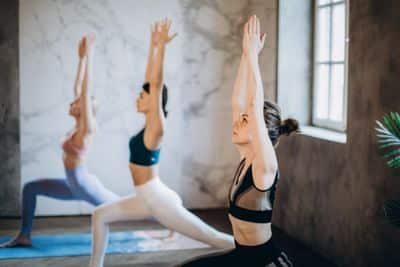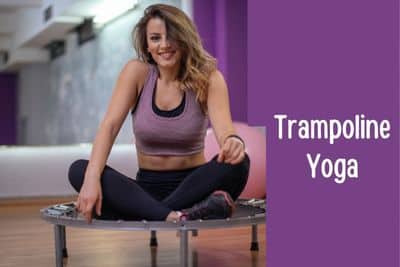If you love yoga, a common question may pop into your mind ‘Can I do yoga on a trampoline’. The short answer is yes, you can use the trampoline mat for yoga. Trampoline yoga will definitely add a new challenge to the trampoline.
So, what is trampoline yoga? It is a fun and dynamic way to practice yoga on the trampoline that combines trampoline bouncing with traditional yoga. This innovative trampoline trick is gradually gaining popularity. This is sometimes called rebound yoga, bounce yoga or aerial yoga. Before you hop on trampoline yoga, you have to learn how to do it rightly.
In this blog, I will explain the key points of trampoline yoga, including its origins, benefits, and different . Let’s dive in!
Benefits of Yoga on Trampoline
Trampoline yoga offers numerous physical and mental benefits, including-

Increased Cardiovascular Fitness
Bouncing on a trampoline is itself a great cardiovascular workout. Moreover, when combined with yoga postures, you will get more effective cardiovascular workouts with fun.
Improved Balance and Coordination
Jumping on the trampoline requires continuous adjustments of your body. Thus, it will help you improve your balance, coordination, and flexibility.
See Also: Is trampoline bad for pregnant?
Low-Impact Exercise
Trampoline yoga is a low-impact exercise that won’t hurt you anyway. So, people with injuries or bad health conditions will find this exercise helpful without hurting them.
See Also: Low-impact rebounder
Increased Core Strength
Some trampoline yoga postures engage your core to maintain balance and stability. These moves will strengthen your core over time.
Stress Reliever and Fun
Trampoline bounce works as a stress reliever. Moreover, when bouncing and yoga combine together, this will help release tension and stress in the body. It will also help in improving sleep disorders. Thus, you will enjoy a happy life overall.
See Also: Backyard trampoline suggestions
Different Trampoline Yoga Exercises
There are different trampoline yoga exercises such as child pose, pyramid pose, half forward bend, triangle pose, plank pose, cobra pose, butterfly pose, cat-cow stretch, etc. Here I will explain several popular trampoline yoga poses.

1. Child Pose
Child pose is a wonderful trampoline yoga pose for beginners. It is also called Balasana. This is good for low back pain relief. So, let’s know how to do it.
- Begin by kneeling on the trampoline mat.
- Sit back on your heels, lowering your hips down towards your feet.
- Reach forward with your arms, stretching them out in front of you on the mat.
- Lower your chest and forehead to the mat, resting your arms alongside your legs.
- Hold the pose for several breaths, focusing on relaxing your muscles and tension in your body.
See Also: How to frontflip and backflip on the trampoline?
2. Tree Poses
Tree poses workout is beneficial for legs, core, hips, etc. It is also called Vrksansana. The steps to do it are-
- Place both your feet on the trampoline mat by distributing weight equally.
- Now lift your left leg and stand on your right leg only. Keep the left foot sole on the right foot thigh.
- Press the foot into the thigh and use your hand to gently lift the other foot higher until the sole of the foot is flat against the thigh.
- Bring your hands together at your heart in a prayer position or reach overhead.
- Stand tall and maintain your balance, breathing deeply.
- Then repeat the actions for the opposite side.
See Also: Can you go on the trampoline during the period?
3. Plank Pose
Planking provides lots of benefits, especially strengthening the core and abdomen. It is also named the front plank or hover exercise. Here are the steps to do a plank.
- Begin by laying on the trampoline on your belly with the help of your elbows. The elbows will go below the shoulders. Keep your body and legs straight while your head is up.
- Lift your body by pressing the toes and forearms on the ground. Keep the whole body straight.
- Relax your neck and be sure you look at the floor. Hold the position for 30 seconds or more you can.
- You can also do a plank by lifting a leg or arm to add more challenges.
The video shows how to do plank exercises.
4. Butterfly Pose
The butterfly pose is a seated yoga pose. Here’s how you can perform the butterfly pose on a trampoline:
- Start by sitting in the middle of the trampoline by extending your legs front.
- Bend your knees and bring the soles of your feet together so your knees fall to the sides. Hold onto your ankles with your hands.
- Gently bounce up and down on the trampoline, pressing your knees down towards the mat like a butterfly.
- Breathe deeply and keep your back straight, focusing on opening your hips and inner thighs.
- Then do some twisting of your hip circularly. Repeat the twisting in the opposite direction.
See Also: Different types of mini-trampoline exercises
5. Sphinx Pose
The sphinx pose is a common yoga posture that is also known as Salamba Bhujangasana. It is often performed on a mat, but it can do it on a trampoline for a more dynamic and challenging experience. The steps to do the sphinx pose on the trampoline are-
- Start by laying down on the trampoline mat and spreading your legs and arms on the trampoline like a starfish. During the spreading legs and arms do inhale out.
- Then bring the arms and legs together and continue doing these for 2 to 3 minutes. At this time, exhale back together.
- Now roll on your stomach on the trampoline and get on your stomach. Be sure your forehead is down, breathe for a while, and relax.
- Then push your body in the sphinx pose while keeping your toes straight and hands in a straight and forward position.
- Now relax your shoulder and inhale and exhale continuously for a while. Be sure your body is in tension.
- After that, back down your body and exhale. And bring your arms and toes back and inhale.
- Then keep your shoulders up off the ground. You can also grab your hands to make it more challenging.
- Now exhale and back down the body. Again, lift up your head, hands, and feet and exhale for the pose.
The following video shows different yoga workouts on a trampoline.
Tips for Getting Started with Rebound Yoga
If you’re interested in trampoline or rebound yoga, here are some tips to consider before you get started.
A) Consult with the Doctor
It’s recommended to get your physician’s opinion before starting rebounding or trampolining yoga. This is a must if you have any previous injuries like back pain or joint pain.
B) Get the Best Yoga Trampoline
You should find the best trampoline that is designed for yoga purposes. It uses cushion materials for safety. JumpSport 250 fitness rebounder is a good model for yoga exercise.

C) Find a Qualified Coach
Like any other exercise, it’s important to find a qualified instructor who can guide you through the practice safely and effectively. Look for teachers who are certified in trampoline yoga and who have experience coaching this unique form of yoga.
D) Wear Appropriate Clothing
Make sure you wear comfortable, stretchy clothing that allows you to move freely on the trampoline. Avoid loose or baggy wearing that could get caught in the trampoline’s springs or hinder your movement.
E) Start Slowly
Trampoline yoga can be challenging, especially if you’re new to the practice. Start with simple postures and moves as your balance and coordination improve gradually. And it’s recommended to do some warm-ups and basic stretching before starting the trampoline yoga exercise.
Takeaways
In wrap-up, trampoline yoga provides lots of benefits over traditional yoga. It improves your physical health and helps you be happy. Hopefully, this article will help you to do trampoline yoga on the trampoline or rebounder.
If you’re interested in trying trampoline yoga, start it with an experienced instructor and have the awesome benefits.

Rebecca is a fitness nerd and mother. She was inspired to get into the world of trampolining and rebounding by her husband Robert, who is a well-respected trainer and expert in the field. Now she instructs children, mothers, and teens the basic trampolining and rebounding tricks.
Rebecca is also a passionate blogger, sharing her knowledge and experiences with others in the hope of encouraging them to give trampolining and rebounding a try.
